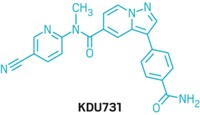Advertisement
Grab your lab coat. Let's get started
Welcome!
Welcome!
Create an account below to get 6 C&EN articles per month, receive newsletters and more - all free.
It seems this is your first time logging in online. Please enter the following information to continue.
As an ACS member you automatically get access to this site. All we need is few more details to create your reading experience.
Not you? Sign in with a different account.
Not you? Sign in with a different account.
ERROR 1
ERROR 1
ERROR 2
ERROR 2
ERROR 2
ERROR 2
ERROR 2
Password and Confirm password must match.
If you have an ACS member number, please enter it here so we can link this account to your membership. (optional)
ERROR 2
ACS values your privacy. By submitting your information, you are gaining access to C&EN and subscribing to our weekly newsletter. We use the information you provide to make your reading experience better, and we will never sell your data to third party members.
Biological Chemistry
Companies Meet Vaccine Needs
Yellow fever outbreak and neglected diseases spur corporate vaccine efforts
by Ann M. Thayer
March 3, 2008
| A version of this story appeared in
Volume 86, Issue 9
A South American outbreak of more than 100 suspected cases of yellow fever has mobilized global health groups and their drug industry partners to supply needed vaccines. There is no treatment for the viral disease, only prevention via immunization. Thus, vaccinations must be given quickly after an outbreak to keep yellow fever from spreading, particularly in populated areas.
Early last week, the United Nations Children's Fund (UNICEF) delivered to Paraguay 2 million doses of vaccine supplied by Sanofi Pasteur, the vaccines division of France's Sanofi-Aventis. The drug company is a leading manufacturer of yellow fever vaccine and supplies an emergency stockpile managed by an international group that includes UNICEF.
Previously, Brazil and other countries in the region provided some of the needed vaccine. Brazilian officials, however, suspended exports of yellow fever vaccine after an outbreak in their country, according to the World Health Organization. At the request of health authorities, Sanofi Pasteur supplied 4 million doses of its yellow fever vaccine to Brazil in early February. The vaccine stockpile now contains only 6 million doses, WHO says, but an additional 18 million should come from manufacturers by the end of April.
Meanwhile, the Swiss firm Novartis has opened the Novartis Vaccines Institute for Global Health (NVGH) in Siena, Italy. It is Novartis' second institute focused on neglected diseases of the developing world—the company set up the Novartis Institute for Tropical Diseases in Singapore in 2002—and the first by a major vaccine developer. Allan Saul, formerly with NIH's National Institute of Allergy & Infectious Diseases, will head the nonprofit institute.
The institute will focus its initial efforts on diarrheal diseases arising from Salmonella typhi, Salmonella paratyphi A, and nontyphoidal salmonellae (NTS) bacteria, which cause infection and disease in children. Multi-drug-resistant NTS is a leading cause of death for African children under five.
The institute's goals are to bridge the gap between basic research and product development and to leverage public-private partnerships. Vaccines discovered by NVGH will first be introduced in developing countries. "Accessibility to and affordability of NVGH products will be the priority, not commercial value or profit potential," says Paul Herrling, head of corporate research at Novartis.



Join the conversation
Contact the reporter
Submit a Letter to the Editor for publication
Engage with us on Twitter